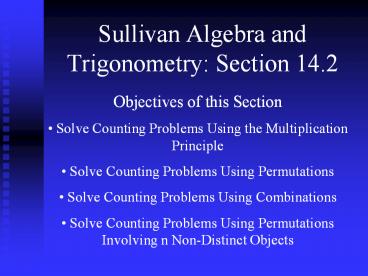Sullivan Algebra and Trigonometry: Section 14.2 - PowerPoint PPT Presentation
Title:
Sullivan Algebra and Trigonometry: Section 14.2
Description:
Sullivan Algebra and Trigonometry: Section 14.2 Objectives of this Section Solve Counting Problems Using the Multiplication Principle Solve Counting Problems Using ... – PowerPoint PPT presentation
Number of Views:129
Avg rating:3.0/5.0
Title: Sullivan Algebra and Trigonometry: Section 14.2
1
Sullivan Algebra and Trigonometry Section 14.2
- Objectives of this Section
- Solve Counting Problems Using the Multiplication
Principle - Solve Counting Problems Using Permutations
- Solve Counting Problems Using Combinations
- Solve Counting Problems Using Permutations
Involving n Non-Distinct Objects
2
Multiplication Principle of Counting
If a task consists of a sequence of choices in
which there are p selections for the first
choice, q selections for the second choice, r
selections for the third choice, and so on, then
the task of making these selections can be done
in
different ways.
3
If a license plate consists of a letter, then 5
numbers, how many different types of license
plates are possible?
4
A permutation is an ordered arrangement of n
distinct objects without repetitions. The symbol
P(n, r) represents the number of permutations
of n distinct objects, taken r at a time, where r
lt n.
Example How many ways can you arrange 7 books on
a shelf?
There are 7 choices for the first book, six
choices for the second book (since the first was
already picked), etc...
So (7)(6)(5)(4)(3)(2)(1) 7! 5040 ways
5
Number of Permutations of n Distinct
Objects Taken r at a Time
The number of different arrangements from
selecting r objects from a set of n objects
(r lt n), in which
1. the n objects are distinct
2. once an object is used, it cannot be repeated
3. order is important
is given by the formula
6
Suppose you were in charge of selecting four
performers from a group of twelve to perform at a
talent show. How many ordered arrangements of
performers do you have to choose from?
Since you are selecting 4 from 12, find P(12,4)
7
A combination is an arrangement, without regard
to order, of n distinct objects without
repetitions. The symbol C(n, r) represents the
number of combinations of n distinct objects
taken r at a time, where r lt n.
8
Number of Combinations of n Distinct Objects
Taken r at a Time
The number of different arrangements from
selecting r objects from a set of n objects
(r lt n), in which
1. the n objects are distinct
2. once an object is used, it cannot be repeated
3. order is not important
is given by the formula
9
(No Transcript)
10
How many ways can you form a committee of three
people from a group of 25?
Since you are selecting 3 from 25 and order does
not matter, we find































